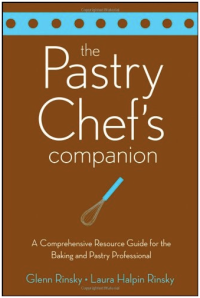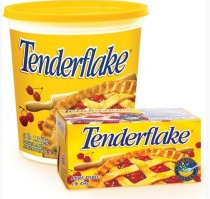Another baking science lesson…….all fats are not created equal! In the bakeshop, we use several different types of fat based on the final desired outcome of the product. In general, we can define a fat as a lipid that is solid at room temperature, whereas an oil is a lipid that is liquid at room temperature. Certain methods of preparation (MOP’s) require specific types of fat. Example: the creaming method for mixing most cookies requires a solid fat like butter (or shortening). The blending method for making muffins requires an oil. The rubbing method for making pie crusts needs a solid fat like lard (or butter, shortening or a combination).
Let’s look at the characteristics of a few different types of fats and oils. Although these photos are showing brand names, I am not endorsing any of these products. Personally, I prefer to use butter in nearly all of my baking recipes, but it is important to know what products are available and the differences between them.
Butter. There are generally two different types of butter: sweet cream and cultured.
Sweet cream butter, a mass-produced butter, is made from cream that has undergone little or no storage which results in a very mild flavor. It is available in both salted and unsalted varieties. European style butter is made more slowly with cream that has developed a deeper flavor and often has bacterial cultures added to it to enhance the flavor. While sweet cream butter has an 80% fat content, European style butter has an 82 – 86% fat content. The remaining percentages are made up with water, milk solids and minerals.
Margarine, very similar to butter in fat content, is composed of hydrogenated vegetable oils, flavors, and colors. It boasts a lower saturated fat content and less cholesterol, but may also contain trans fats. If choosing margarine for health reasons, please do your research as there are a variety of brands that are processed differently.
Oil. There are many varieties of oil, including corn oil, canola oil, peanut oil, olive oil, and vegetable oil. All of these oils are 100% fat and remain liquid at room temperature. Flavor varies with the type of oil so when choosing a product to use in a baking recipe, I recommend one with a mild flavor.
Shortening, a hydrogenated vegetable oil which makes it a solid at room temperature, has very little flavor and a waxy consistency. All purpose shortening may be used for pie crusts, cookies, biscuits and for frying. Shortening has an extremely long shelf life and has a higher melting point than butter. (The higher the melting point of the fat, the flakier the product will be.)
Lard, rendered and purified pork (usually) fat, has a relatively high melting point that makes it perfect for flaky pastry. Remember the picture of my blueberry pie from my first post? That pie crust was made with lard. Depending on the quality of the lard, some brands may be more suitable for savory dishes as they have a bit of a meaty flavor. (This particular brand is nearly flavorless.)
Functions of fats: Fats in recipes provide moistness (muffins), tenderness (cakes), flakiness (croissants), flavor (shortbread cookies) and extend shelf life. Choose your fat wisely!
The following photos are of some products that rely on fat for their characteristic flavors and textures.
What’s your favorite fat for baking? What makes it your favorite: the flavor, the mouthfeel or how it functions in your product?
.Here’s another of my favorite books! This edition, set up like a dictionary, gives a brief history, definition or description of everything from basic ingredients to classic recipes. This book is “must have” for your culinary bookshelf. 









